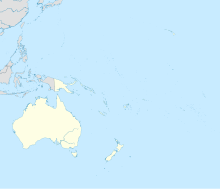Auckland Airport Taunga Rererangi o Tāmaki-Makaurau | |||||||||||||||
|---|---|---|---|---|---|---|---|---|---|---|---|---|---|---|---|
 | |||||||||||||||
 | |||||||||||||||
| Summary | |||||||||||||||
| Airport type | Public | ||||||||||||||
| Owner/Operator | Auckland International Airport Limited | ||||||||||||||
| Serves | Auckland | ||||||||||||||
| Location | Ray Emery Drive, Māngere, Auckland, New Zealand | ||||||||||||||
| Opened | 29 January 1966 | ||||||||||||||
| Hub for | Air New Zealand | ||||||||||||||
| Focus city for | Qantas | ||||||||||||||
| Operating base for | |||||||||||||||
| Time zone | NZST (UTC+12:00) | ||||||||||||||
| • Summer (DST) | NZDT (UTC+13:00) | ||||||||||||||
| Elevation AMSL | 7 m / 23 ft | ||||||||||||||
| Coordinates | 37°00′29″S 174°47′30″E / 37.00806°S 174.79167°E | ||||||||||||||
| Website | www | ||||||||||||||
| Maps | |||||||||||||||
 | |||||||||||||||
 | |||||||||||||||
| Runways | |||||||||||||||
| |||||||||||||||
| Statistics (2023/2024) | |||||||||||||||
| |||||||||||||||
Source: WAD[4] | |||||||||||||||
Auckland Airport[5] (IATA: AKL, ICAO: NZAA) is an international airport serving Auckland, the most populous city of New Zealand. It is the largest and busiest airport in the country, with over 16 million passengers served in the year ended August 2023.[6] The airport is located near Māngere, a residential suburb, and Airport Oaks, a service-hub suburb 21 kilometres (13 mi) south of the Auckland city centre. It serves as the principal hub for Air New Zealand, and the New Zealand operating base for Jetstar.
The airport is one of New Zealand's most important infrastructure assets, providing several thousand jobs for the region. It handled 71 per cent of the country's international air passenger arrivals and departures in 2000.[7] It is one of only two commercial airports in New Zealand that can handle Airbus A380 jet aircraft (the other being Christchurch).
The airport has a single 3,535 m (11,598 ft) runway, 05R/23L, which is Cat IIIb capable (at a reduced rate of movements) in the 23L direction. It has a capacity of about 45 flight movements per hour, and is currently the busiest single-runway airport in Oceania.[8] In November 2007 work began on a new northern runway, to be built in several stages and to be used mainly by smaller aircraft, freeing up capacity on the main runway. The project was delayed several times and as of 2023 no date has been announced for its completion. The airport currently covers 1,500 hectares (5.8 sq. miles) of airport property.[9]
Currently there are two terminals: International and Domestic. In 2023 the airport announced plans for all jet flights to use a single, expanded terminal, with turboprop flights continuing to use the existing domestic terminal.[10]
- ^ "Monthly traffic updates". AIACorporate.
- ^ "January 2024 Monthly Traffic Update". Auckland airport. Retrieved 15 February 2024.
- ^ a b "Auckland airport – Economic and social impacts". Ecquants. Archived from the original on 12 May 2014. Retrieved 7 September 2013.
- ^ "AUCKLAND INTL". World Aero Data. WorldAeroData.com. Archived from the original on 2 March 2020. Retrieved 2 March 2020.
{{cite web}}: CS1 maint: unfit URL (link) - ^ "Te marae o Te Mānukanuka o Hoturoa, Te Taunga Rererangi o Tāmaki-makaurau – Te whakahaere marae – Te Ara Encyclopedia of New Zealand".
- ^ "AIA Monthly Traffic Update Month July 2023 and August 2023 Preview". Auckland Airport.
- ^ "Tourism and migration 2000, Part 1: International passenger traffic". Statistics New Zealand. 2000. Archived from the original on 17 October 2015. Retrieved 8 June 2015.
- ^ Cite error: The named reference
HERwas invoked but never defined (see the help page). - ^ "Auckland Int'l Airport Fast Facts". corporate.aucklandairport.co.nz. Retrieved 16 November 2023.
- ^ "Building the gateway New Zealand needs: Multi-billion-dollar investment in future of travel at Auckland Airport". 17 March 2023.


